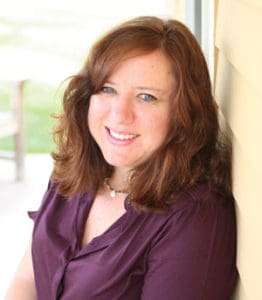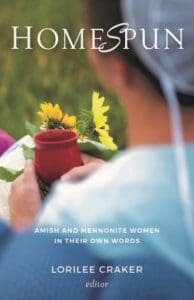Behind Amish romance novels, tourist spots and “reality” TV shows stand real people, with longings and loves just like the rest of us. Every Amish and Mennonite woman has a story. What would it be like to be welcomed into their homes and share those stories over a cup of coffee?
In the pages of Homespun: Amish and Mennonite Women in Their Own Words (Herald Press), Amish and Plain Mennonite women swap stories and spin yarns while the reader sits in. The book’s editor, Lorilee Craker, bestselling author of Money Secrets of the Amish, collected these personal writings and authentic perspectives on life, hospitality, home, grief, joy, and walks with God from Anabaptist women’s periodicals. Among the stories shared are essays penned by well-loved Amish and Mennonite writers such as Sherry Gore, Linda Byler, Lovina Eicher, Dorcas Smucker, and Sheila Petre.
 Q: You describe yourself as a simple Mennonite girl from the prairies. Can you share a little bit about your childhood?
Q: You describe yourself as a simple Mennonite girl from the prairies. Can you share a little bit about your childhood?
My childhood was deeply rooted in the Mennonite culture. Growing up, I witnessed my two grandmothers with their hair in a bun and always wearing dresses or skirts. I thought this was normal! None of my grandparents spoke English—all four of them spoke German or Low German. At family gatherings we would eat Mennonite food such as borscht, varaneki (pierogies), platz (fruit strudel), and pluma moos (cold plum soup). We also ate those things in my home, so again, this was all very normal. We were also bound by similar values of faith and peace, and by stories of where we had come from.
Q: Your family’s roots in Mennonite communities run deep, but your family history is an example of the many different stories people have. Can you tell about both your mother and father’s background?
My mother’s family came over from Ukraine in the 1870’s. They were pioneers who homesteaded on the prairies, but they never lost their culture or assimilated too much into the broader community. The ties of language, food, and culture that bind them to their pioneer great-great-grandparents are startlingly durable.
My dad’s family had a completely different story. They came in the third wave of immigration from Ukraine, after World War II. They fled Stalin as refugees and experienced his holocaust. My dad lost his twin sister to starvation, so those stories were imprinted painfully on his heart.
I knew from early on that there were lots of different kinds of Mennonite stories.
Q: Growing up in Manitoba where there was a large Mennonite population, you didn’t realize most people didn’t live the same way you did. What was the biggest adjustment for you when you moved to Chicago for college?
The biggest adjustment was that no one seemed to know what a Mennonite was, or they assumed that I should be wearing a bonnet and driving a buggy like the Amish! Everyone seemed to think that being Amish or Old Order Mennonite and being my kind of Mennonite were one and the same. This assumption led to lots of explanations on my part about the difference between my modern Mennonite upbringing (“like Baptist, with a German accent and special foods”) and those other related subcultures.
People were surprised that I wore makeup and nail polish, etc. In Winnipeg, people knew that Mennonite women were modern because they knew so many of them. That wasn’t the case in Chicago.
Q: Explaining how you were Mennonite, not Amish, eventually led to you writing your previous book, Money Secrets of the Amish. What did you learn in that process that made you feel more connected to what your roots?
As I visited Amish homes and barns in Michigan and Pennsylvania for my 2011 book, I recognized bits of their dialect, Deitsch (Pennsylvania German), from my spotty grasp of Low German. Their baby naming customs were also similar. The Amish women’s hair buns and long skirts, not to mention the tantalizing aromas of fruit strudels (Platz, to me) baking in their ovens, reminded me of my beloved grandma Loewen. I recalled my little dynamo of an Oma (grandmother) tsk-tsk-ing me about the length of my skirt. She always had a twinkle in her eye as she chided me, but I still made sure to go for full coverage as I interviewed the Amish.
The peace and gentleness I felt when visiting the Amish reminded me so much of visiting my Grandma’s farm. I felt oddly at home among my spiritual and cultural cousins. It was amazing to me that over 300 years had passed since our break up and we still had things in common! I came to realize were more closely tied to me and my upbringing than I had ever dreamed.
Q: What are some of the differences between Mennonite and Amish beliefs? What are the biggest similarities?
While there is a great variety of Mennonite culture, practices and lifestyles, from very old-fashioned to very modern and even progressive, the Amish are much more the same across their communities. They are extremely dedicated to living much like they did in 1693, when they split off from the Mennonites over the matter of buttons. Mennonites were okay with buttons, but tailor Jacob Amman’s followers, the Amish, thought they were worldly. To this day Amish fasten their clothes without buttons.
The similarities lie in spiritual roots of being peace-loving, set apart people with a radical faith. The most modern Mennonite in downtown Winnipeg might name their children Isaiah, Ezra, and Naomi, and the most conservative Amish will have children with those same Bible names. They have both kept some remnant of their dialect—Amish speak Pennsylvania Dutch which is really Deutsch—German. I was startled to recognize bits of the Amish dialect as being similar to my own Platt Deutsch—low German. Foods are similar sometimes, too. And food customs, like Faspa, which is a cold meal served on Sunday late afternoon so the ladies wouldn’t have to cook on Sunday.
 Q: What was the inspiration behind your new book, Homespun? How did you collect the stories included in the book?
Q: What was the inspiration behind your new book, Homespun? How did you collect the stories included in the book?
Herald Press approached me about being the general editor of a collection of writings from Amish and Mennonite women. I collected the stories from mainly two sources, Daughters of Promise magazine, a beautiful and beautifully written literary journal done by conservative Mennonite women, and Ladies Journal, a much more spare periodical by Amish women.
It was thrilling for me to discover new writers and incredible writing from mostly unknown writers! These women have a lot to say and I was fascinated by their take on modern life. To hear from women specifically appealed to me, as a feminist. Sometimes in conservative subcultures, their voices are silenced or muted. This book gives them space and grace to speak.
Q: What themes did you notice emerging as started compiling the stories? How is Homespun organized?
As I read stories for the book, a number of themes arose, so I arranged the stories by those topics and wrote a brief introduction tying them together.
Welcome. A deep sense of hospitality is fundamental to these women. Yet it’s not hospitality in the HGTV, your-house-needs-to-be-perfect kind of way. As one of the writers shares, it is easy to overthink hosting, but Jesus made it look quite simple, and his hosting style can be described in one word: love.
Abide. Hospitality is sacred and spiritual, but it doesn’t mean these writers don’t want to have an appealing home space in which to dwell. They want to abide in an abode, if you will, that nurtures them and feeds their spirit. The writers here expound beautifully on what home means to them.
Testimony. Story makes the world go round. When we hear the stories—the testimonies—of others, we are better able to understand our own story and our place in the world. These narratives stirred different emotions in me.
Wonder. The blazing faith of early Anabaptists is evident in the openness of these writers to all things wondrous. These are true stories of miracles, phenomenal happenings that don’t make sense from a human perspective. They highlight the possibility of the miraculous happening all around us, in big ways and small.
Kindred. A core value of both Mennonites and Amish is the preeminence of family—kinfolk, whether they be kindred or not. Our kin shape us in ways both known and unknown, good and bad. These essays and stories speak to the tremendous influence of family.
Beloved. These essays enthused my soul, and I came away feeling as if I had just been to church. My cup had been filled. There is something wonderfully elemental and childlike about the devotion expressed here, devotion even in doubt. These pieces drew me closer to the One who calls all his daughters “beloved.”
Q: In what ways were you challenged to rethink your concept of welcome and hospitality?
In our HGTV era, we can begin to believe that hospitality equals a perfectly renovated and decorated space. I love all that stuff, and that’s great, but these writers helped me get back to the true meaning of opening your home to others. I had just bought this table set for my patio, but all summer had hosted only one time. Why? Because of the weeds! Meanwhile, I could have blessed my guests all summer. These essays helped me get back to the idea of lengthening the table, not caring as much if things were “perfect.”
Q: The advice in the abide section varies from painting your home bright colors to reflect yourself to having plenty of white space. However, decorating tips really aren’t the point. How does the section on abide differ from hospitality?
Hospitality is about opening your home to others, while the act of dwelling is different. How do we create a nest that nurtures and shelters us? Bethany Hege’s piece called “White Space” is one of the loveliest pieces in the book and one of the most insightful things I have ever read on the topic of home décor and design. “Keep it simple but keep it significant,” she writes. Her words really challenged me to do just that. For example, I framed an 8 x 10 print which reads, “Cheap Like Borscht,” a saying known to Russian Mennonites and something my dad would always say. Every year, I make sure and buy gladioli because they were my Grandma’s favorite flowers. I hung a large photo of a field with flax and canola—the two crops my Grandpa farmed—over my fireplace. To me, I am keeping things simple but significant.
Q: All of the stories in Homespun could actually fall under the category of testimony, but how do the stories in that section stand out among the others?
“The Lord is My Rock” profoundly moved me. Ervina Yoder tells about giving birth to her stillborn son. “I go to the grocery store and no one knows I’m a mommy,” she writes. Every time I read that I get chills of sorrow. Yet her faith also gives me chills.
Q: Can you share one of the modern-day miracle stories included in the book?
Danielle Beiler’s “When You put Your Money in God’s Bank Account” is one of my favorite pieces in the book. It’s a very detailed journal, really, of God’s provision for her day to day. I love how she never ran out of gas, no matter how low her tank got. It reminds me of manna from Heaven, except in this case manna was fuel!
Q: How is the preeminence of family different among the Mennonites and Amish versus those in other communities?
I think the biggest thing is our shared experiences. We are the “peculiar people,” an ethnic subculture with no homeland (so people don’t think we are an ethnicity) with a shared history of terrible suffering (especially the Russian Mennonites, the most recent wave of immigration from Ukraine who still have family members who remember living in Stalinist Russia). Those shared experiences set us apart and make our families close knit because we understand each other in a way no one else does.
Q: What does it mean to be one of God’s beloved? How do the stories reflect that belonging?
These women have a deep, radial faith that spreads so much light. This was the hardest section from which to choose because there were so many moving pieces. “Rebuilding from the Shambles of Shame,” for example, is profound. She compares the process of rising up out of shame to restoring a crumbling old house. Often while reading these pieces I felt stirred and uplifted.
Q: What do you ultimately hope readers will gain from reading Homespun?
I hope they will find a pocket of peace and gentle witness in their hectic, modern lives. These women have a countercultural, singular mindset that is refreshingly different. I hope our readers will see their own stories in a new, Homespun light!
Learn more about Lorilee Craker online at lorileecraker.com. You can also find her on Facebook (@LorileeCraker), Twitter (@lorileecraker) and Instagram (@thebooksellersdaughter).
I hope everyone enjoyed the interview with Lorilee! We have one copy of Homespun: Amish and Mennonite Women in Their Own Words to give away. To enter, leave a comment below. One winner will be selected at random and announced on Saturday, September 8th. Good luck and don’t forget to share this giveaway with your friends!
Giveaway starts today, Friday, August 31st and ends Friday, September 7th and is only open to US residents.



33 thoughts on “Homespun: Interview and Giveaway with Lorilee Craker”
Interesting, informative article. I really enjoyed it. Would be thrilled to add this book to my collection. Thank you.
pretty intetesting and id live to red
Thank you for telling readers about your book Homespun here on Destination Amish. Your book sounds very interesting to someone who has a curious mind about the Mennonites and Amish. I would enjoy reading it. Thanks for you generous giveaway. Would love to win your book.
I love reading about the Amish and Mennonites. They have such a sense of community. It makes me long for heaven, but gives me peace on earth.
very interesting article, I would love to win this book.
I was brought up with Mennonites and Dunkard Bretheran. I would love to read this book. Thanks for a chance to win.
Loved the interview , very informative questions and answers. Would Love to add this book to my collection. Thank you.
What an interesting take on the Anabaptist life. Would enjoy reading this one.
Thank you for the opportunity to win this book. I believe women of all cultures and generations share a common bond-that of nurturing and loving unconditionally. I look forward to reading this book.
Sounds like a fascinating read and very informative. Looking forward to this one. Enjoyed the interview very much.
Your book “Homespun” sounds very interesting, as I love to learn more about the life of Amish and Mennonites.
Wow, this sounds like such a wonderful book. I love the information you gave in the interview and the snippets of what is included in this book. It really sounds like a book for all. Thank you for the chance to win a copy and for writing what is bound to be a heart felt read.
Sounds like a great book! Thanks for offering one for free. I would definitely read it.
I love learning about the Amish and Mennonite. They inspire me to live a better life. I would love to win this meaningful book.
this sounds like a really interesting book!
I would like to read this I think it will give me different outlooks on things I may see only one way
Beautiful cover and the stories sound very interesting.
Thanks so much for the interview. I can’t wait to read the book.
I loved reading her interview. I am adding Homespun to books I will order and read. The accounts from someones life is very interesting.
I really enjoyed this article. Thanks for the chance to win.
I enjoyed reading the above article. Very informative. Would also like your book “HomeSpun”, sounds very interesting.
Loved the interview and found your Mennonite ties interesting. I admire the Amish & Mennonites life styles and how true they are to their heritage – God first.
Your book sounds very . I would enjoy learning more about the Amish and Mennonites.
Definitely adding to my to be read book list. Loved the interview
Would love to win, I like reading about the Amish
Sounds like a very interesting book to shed some light one the Amish and Mennonite culture.
What an absolutely lovely interview! I am looking forward to reading this book!
Sounds like a really interesting book. Would love to read about the difference between the Amish and Mennonite.
Very interesting. Thanks for a chance to win 🙂
Thank you for sharing your heritage with the Mennonites. I’ve seen some awesome reviews for this book and have had it recommended to me. Blessings. Thank you for the giveaway opportunity.
I enjoyed reading this story. I have a great respect for the Mennonite s and amish. I read and collect amish books. I would love to win this copy and place it with the rest of my collection. God bless you
This book sounds so interesting!
The winner of a copy of Homespun: Amish and Mennonite Women in Their Own Words is Sheri G. Congratulations! Please watch your email for directions on how to claim your book. Thanks for entering, everyone! 🙂